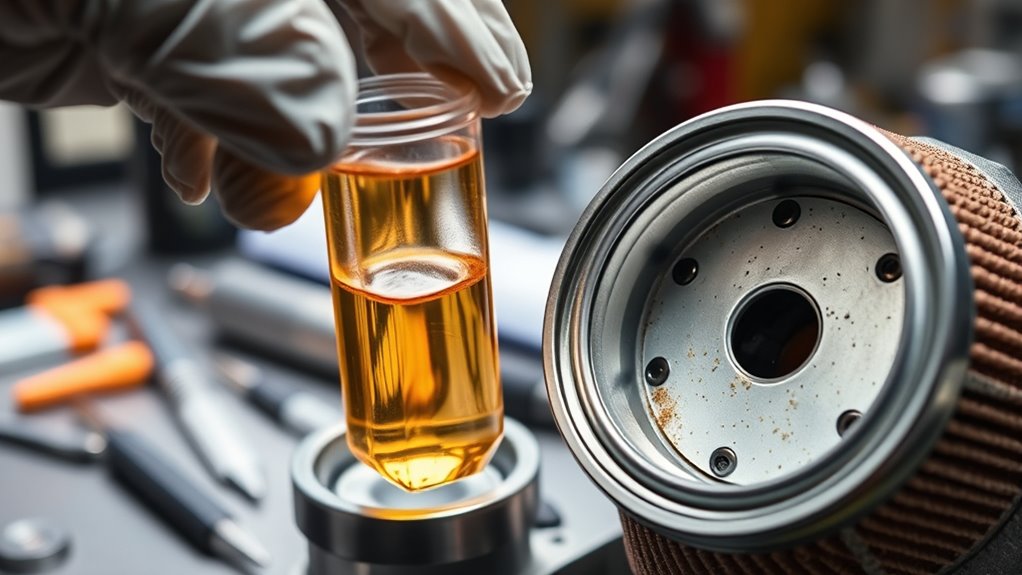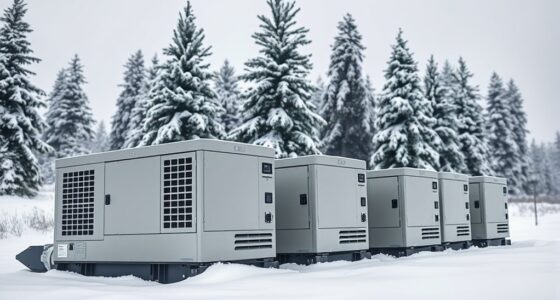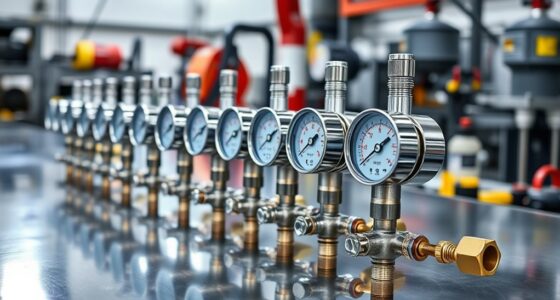To prevent fuel contamination, regularly test your fuel for water, microbes, and dirt using proper kits. Replace filters on time and store fuel in sealed, cool containers away from sunlight. Avoid low-quality or adulterated fuel sources and address water intrusion immediately by draining tanks or sealing leaks. Use additives sparingly to boost fuel quality. If you keep these steps in mind, you’ll reduce risks—continue for expert tips to keep your fuel system clean and efficient.
Key Takeaways
- Regularly test fuel samples with reliable kits to detect contamination early.
- Replace fuel filters promptly and follow a consistent maintenance schedule.
- Store fuel in sealed, approved containers away from sunlight and moisture.
- Drain water from tanks immediately and use additives to prevent microbial growth.
- Seek professional help for persistent issues, tank sealing, and advanced contamination troubleshooting.
Recognize Common Signs of Fuel Contamination
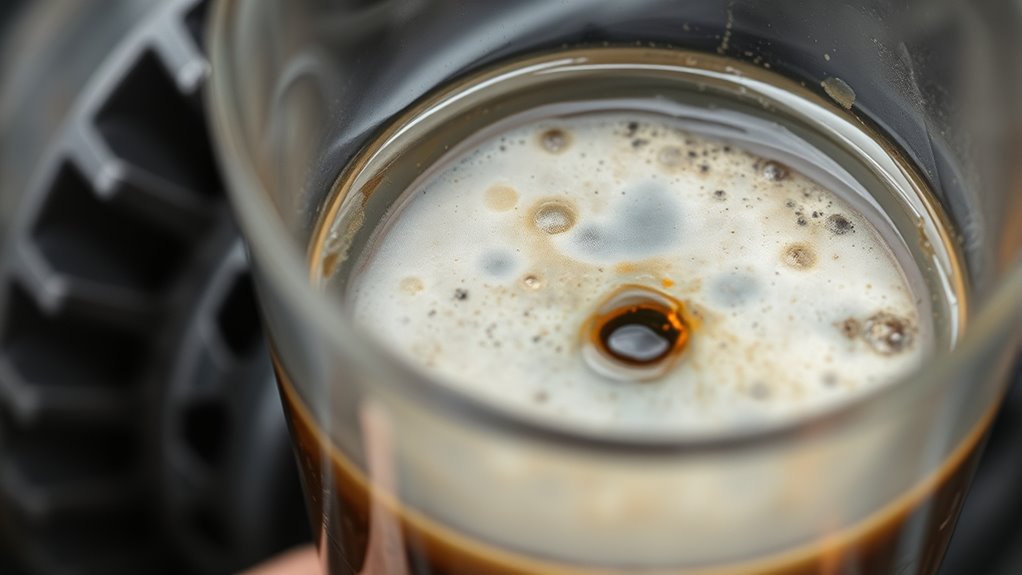
Fuel contamination can cause immediate and noticeable problems in your engine’s performance. One of the first signs is a strange fuel smell, which might indicate water or other impurities mixing with your fuel. You may also notice a color change in the fuel—if it appears cloudy, darker, or murky, it’s a sign that contaminants have entered the tank. These changes can lead to poor engine performance, rough idling, or difficulty starting your vehicle. Pay attention to any unusual odors or visual cues, as they often indicate compromised fuel quality. Addressing these signs early can prevent more serious damage down the line. Recognizing these simple yet critical indicators helps you catch contamination before it causes costly repairs. Utilizing proper fuel testing techniques can further assist in identifying contamination issues promptly.
Test Your Fuel Properly Before Treatment
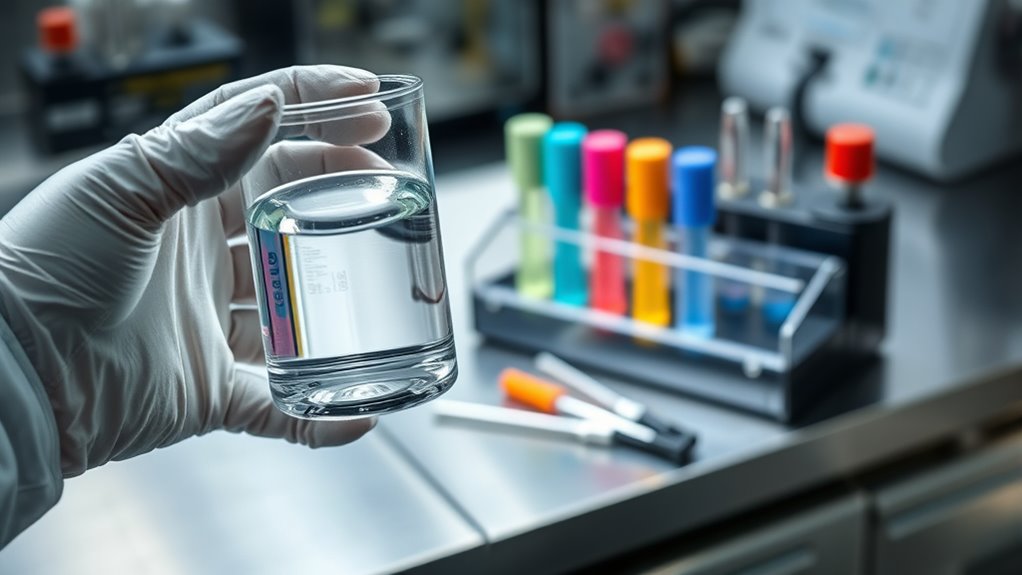
Before treating your fuel, making certain to test it accurately is crucial. Use proper testing methods to identify any water presence and measure contaminant levels. This step ensures you choose the right treatment approach and avoid unnecessary issues down the line. Understanding the signs and symptoms of contamination can help you better interpret your test results and take appropriate action.
Use Proper Testing Methods
Proper testing is essential to determine the true condition of your fuel before applying any treatment. You should perform thorough fuel sampling and contamination testing to identify issues accurately. Using proper testing methods helps prevent unnecessary treatments and ensures fuel quality. Start by collecting representative samples carefully, avoiding contamination. Use reliable test kits or laboratory services to analyze for water, dirt, or microbial contamination. Record your results precisely for future reference. Here’s a quick overview of testing options:
| Method | What It Detects | Recommended Use |
|---|---|---|
| Visual Inspection | Sediment, water | Initial screening |
| Test Kits | Contaminants | Quick checks |
| Laboratory Analysis | Microbial, chemical | Detailed assessment |
| Fuel Sample Collection | Sample integrity | Accurate results |
| Contamination Testing | Hidden impurities | Confirm suspicions |
Proper testing techniques are also crucial for detecting engine performance issues related to fuel quality. Accurate testing guides appropriate treatment, saving you time and money.
Check for Water Presence
Have you checked for water in your fuel lately? Water detection is key to moisture control and preventing fuel issues. To guarantee your fuel is free of water, follow these steps:
- Use a water detection test kit designed for fuel samples.
- Collect a small sample in a clear, transparent container.
- Let the sample sit for a few minutes—water will separate and settle at the bottom.
- Look for visible signs of water or sediment, indicating contamination.
- Regular testing and proper storage conditions help prevent microbial growth and fuel degradation. Fuel stability is essential for maintaining optimal performance.
Performing these simple checks regularly helps you identify water presence early, avoiding corrosion, microbial growth, and engine problems. Proper water detection keeps your fuel clean and your equipment running smoothly. Don’t overlook moisture control—quick tests today save costly repairs tomorrow.
Assess Contaminant Levels
Evaluating contaminant levels is an essential step to guarantee your fuel is suitable for use and to determine if treatment is necessary. You need to identify contaminant types, such as dirt, water, microbial growth, or sediments, to assess fuel quality effectively. Use proper testing methods like dipstick tests, sample analysis, or portable testers to measure contamination levels accurately. Comparing your results against fuel quality standards helps you decide whether cleaning or additive treatments are needed. If contaminant levels exceed acceptable limits, addressing issues promptly prevents engine damage and maintains efficiency. Regular assessment ensures your fuel remains within safe parameters, minimizing risks and ensuring peak performance. Accurate testing is key to preventing costly repairs and keeping your equipment running smoothly. Incorporating fuel testing techniques can help you detect issues early and maintain optimal engine operation.
Use Quality Additives When Necessary
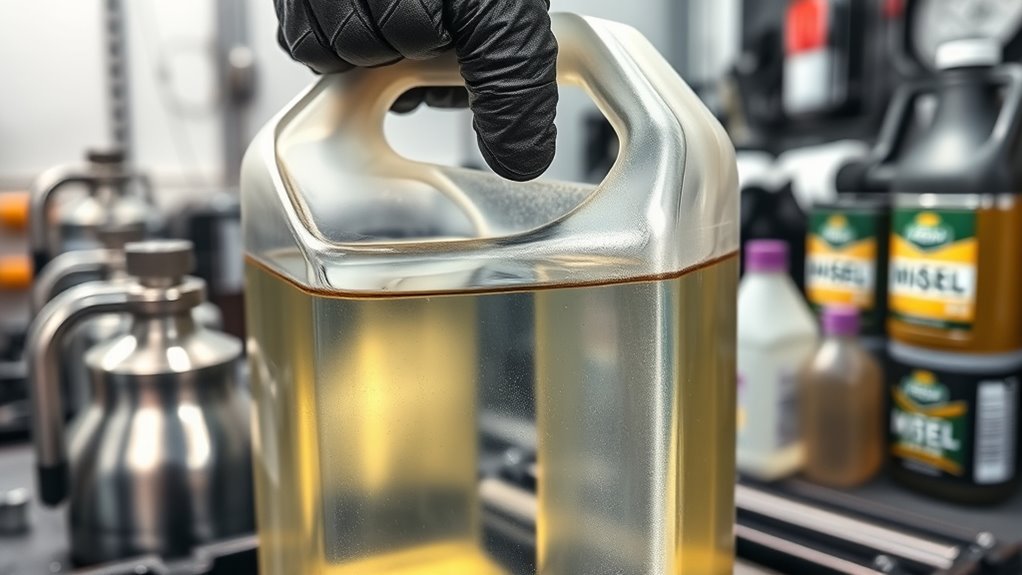
Why should you consider using quality additives in your fuel? Because they enhance performance, protect your engine, and extend fuel life. Quality additives can provide essential fuel additive benefits when used correctly, but only if they’re compatible with your fuel. To maximize their effectiveness, keep these tips in mind: 1. Choose additives designed for your specific engine type. 2. Check for additive compatibility with your fuel grade. 3. Use additives sparingly—more isn’t always better. 4. Follow manufacturer instructions for proper dosing. Additionally, selecting appropriate tuning options can further optimize your vehicle’s performance and fuel efficiency.
Avoid Using Unapproved or Low-Quality Fuel Sources
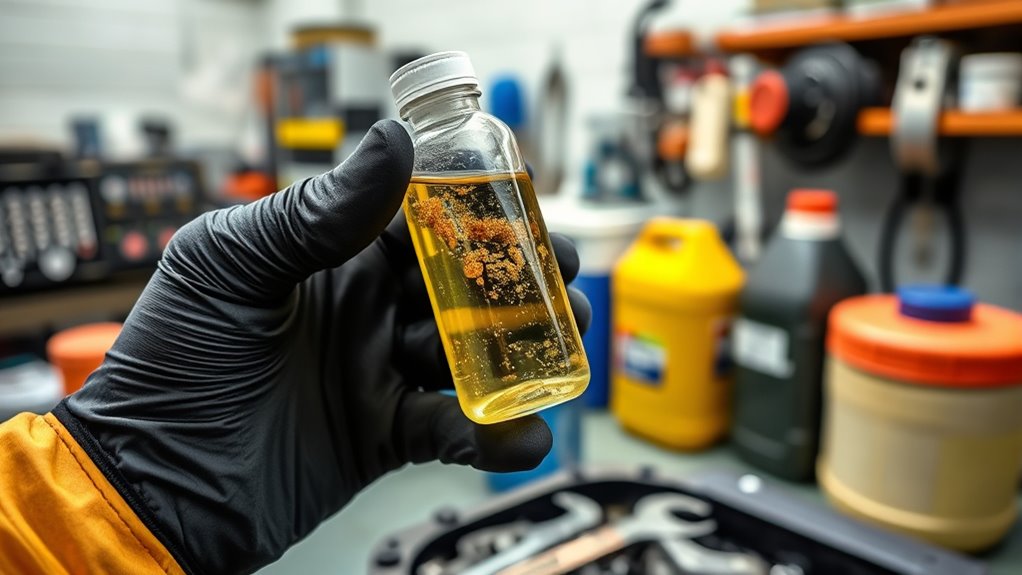
Using unapproved or low-quality fuel sources can lead to serious engine problems and increased maintenance costs. Always check for proper fuel certification to guarantee the fuel meets industry standards. Uncertified fuels may lack the necessary quality controls, risking contamination and engine damage. Pay attention to fuel labeling—reliable labels indicate the fuel’s composition, octane rating, and compliance with regulations. Avoid fuel from unverified sources or those with unclear labeling, as they might contain impurities or additives that harm your engine. Using high-quality, approved fuels helps maintain maximum performance and reduces the risk of clogs, corrosion, and premature wear. Stick to reputable suppliers and always verify that the fuel you purchase is properly certified and accurately labeled for your engine’s requirements. Proper fuel storage and handling also plays a critical role in preventing contamination and ensuring fuel integrity over time.
Implement Regular Fuel System Maintenance
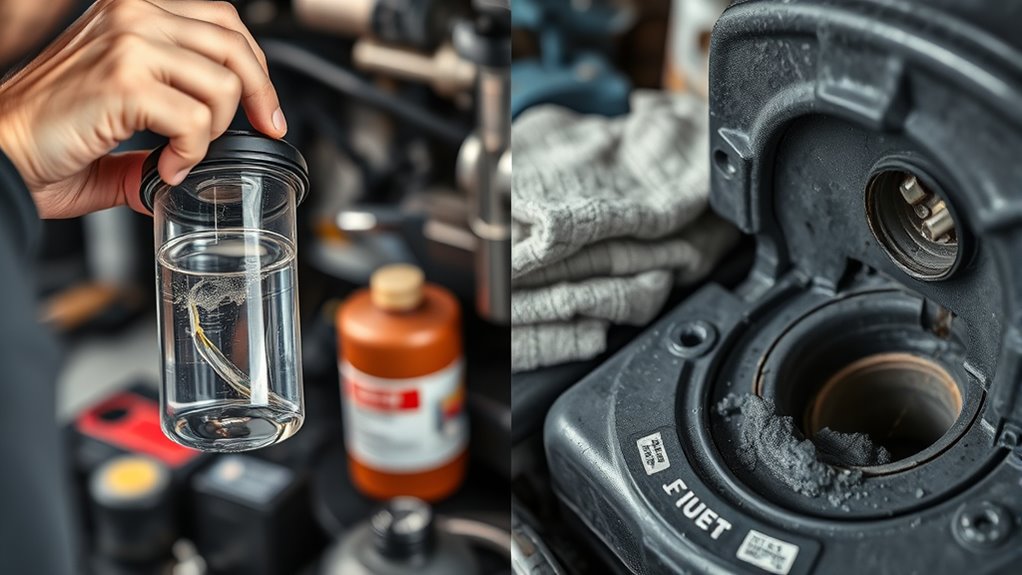
You need to stay on top of your fuel system to prevent contamination issues. Schedule routine inspections, replace fuel filters promptly, and clean your fuel tanks regularly to keep everything running smoothly. Consistent maintenance saves you time and money in the long run. Additionally, using high-quality equipment ensures optimal performance and reduces the risk of issues caused by inferior components.
Schedule Routine Inspections
Regular fuel system maintenance is essential for preventing contamination and ensuring ideal engine performance. Scheduling routine inspections helps you catch issues early, saving costs and avoiding breakdowns. During inspections, focus on:
- Checking for signs of fuel theft, which can cause inconsistent fuel levels and engine problems.
- Examining fuel lines and tanks for debris or water contamination.
- Monitoring fuel quality to identify possible degradation due to improper storage or aging.
- Verifying that fuel pricing remains fair, preventing you from overpaying or falling victim to adulterated fuel.
- Conducting fuel analysis to detect contaminants or degradation that may not be visually apparent.
Replace Fuel Filters Promptly
Replacing fuel filters promptly is crucial for maintaining ideal engine performance and preventing contamination issues. When you perform regular fuel filter replacement, you guarantee contaminants don’t clog your fuel system, which can cause poor engine operation or damage. Proper filter maintenance helps keep fuel clean, reducing the risk of clogged injectors and fuel pump failure. Don’t ignore signs like engine hesitation, reduced power, or difficulty starting—these indicate it’s time to replace the filter. By sticking to a schedule for filter maintenance, you protect your engine and extend its lifespan. Regular fuel filter replacement is a straightforward step that saves you money in the long run and keeps your vehicle running smoothly. Make filter maintenance a priority for optimal performance. Additionally, ensuring your fuel system components are properly maintained and inspected can prevent many common issues caused by contamination.
Clean Fuel Tanks Regularly
Maintaining clean fuel tanks is a key step in preventing contamination that can compromise engine performance. Regular fuel tank cleaning removes sediment, water, and microbial growth that can lead to fuel system issues. To guarantee contamination prevention, consider these actions:
- Schedule routine inspections and fuel tank cleaning every 1-2 years.
- Drain water and remove debris from the tank’s bottom.
- Use fuel additives that inhibit microbial growth and sediment buildup.
- Keep the tank cap sealed tightly to prevent dirt and moisture entry.
Store Fuel Correctly to Prevent Contamination
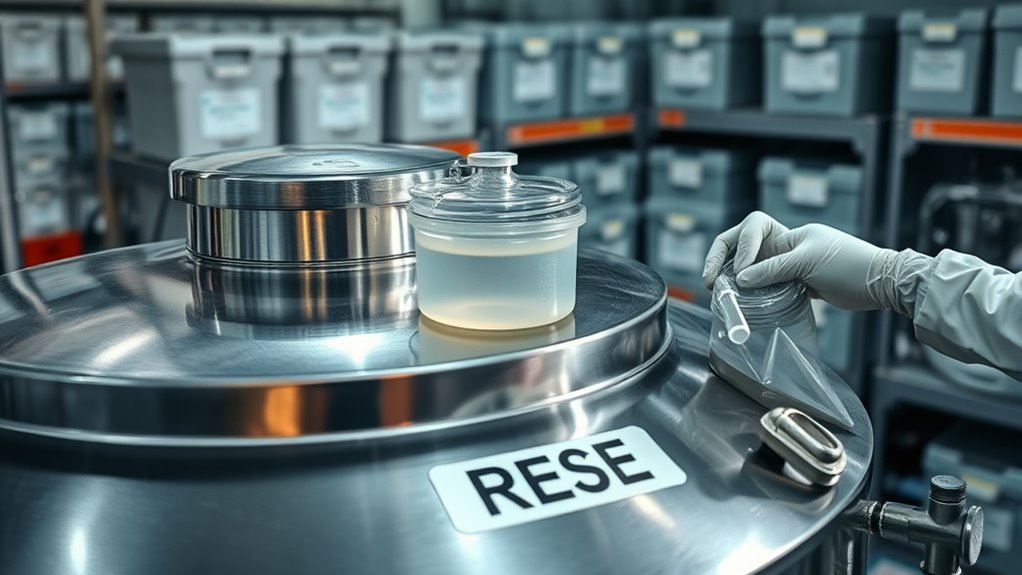
Properly storing fuel is essential to prevent contamination that can damage engines and reduce efficiency. To guarantee storage safety, always keep fuel in approved containers designed for fuel handling, avoiding plastic or makeshift containers that can degrade or leak. Store fuel in a cool, dry place away from direct sunlight and heat sources, which can cause vapor buildup or deterioration. Keep containers tightly sealed to prevent moisture and dirt from entering, and label them clearly with the date of storage to monitor freshness. Regularly inspect your storage setup for leaks, corrosion, or signs of contamination. Proper storage not only maintains fuel quality but also minimizes risks, ensuring your equipment runs smoothly and safely without costly repairs.
Address Water Intrusion Without Causing Damage

Water intrusion in fuel systems can cause serious damage, but addressing it carefully is essential to avoid further harm. To do this effectively, focus on water intrusion prevention and proper fuel tank sealing. Here are key steps:
- Identify the source of water entry—check for cracks or leaks in seals.
- Drain water promptly from the fuel tank using a siphon or drain plug.
- Use water-detecting additives to help absorb residual moisture.
- Re-seal the tank with high-quality fuel tank sealing products to prevent future intrusion.
Always handle water intrusion carefully to avoid damaging sensitive components. Proper sealing and regular inspections keep your fuel system safe and water-free, ensuring ideal performance without costly repairs.
Consult Professionals for Complex Fuel Issues
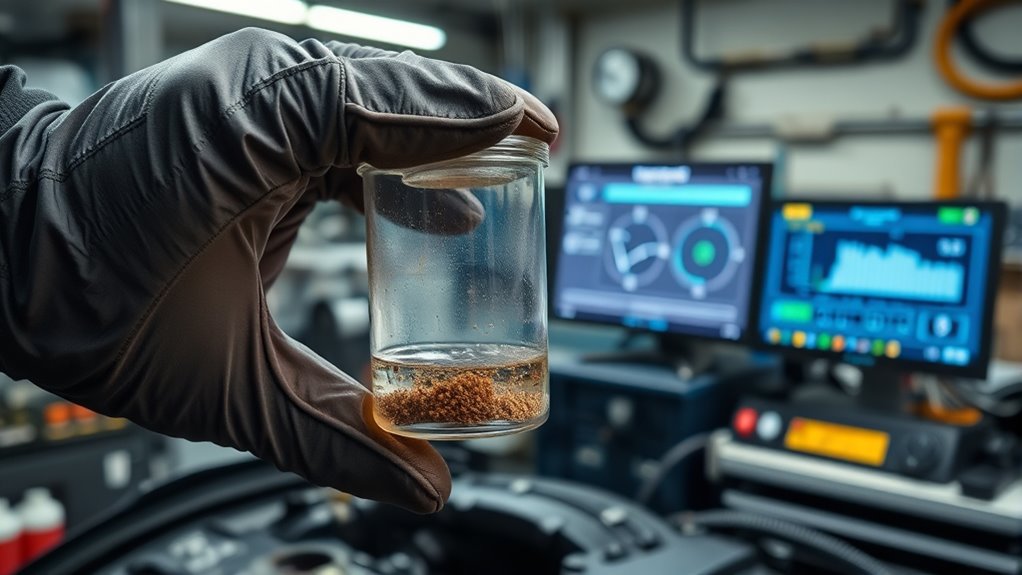
When fuel issues become too complex or persistent to resolve with basic troubleshooting, consulting experienced professionals is the most effective course of action. They can accurately diagnose problems like fuel contamination or engine damage, saving you time and money. Professionals also provide expert advice on fuel additive selection, helping prevent future contamination. Their skills ensure you get the right solutions tailored to your equipment’s needs. Remember, tackling complex fuel problems without guidance can make things worse. Reach out to specialists who understand contamination prevention and fuel quality management. They can perform thorough tests, recommend necessary treatments, and ensure your fuel system operates smoothly.
| Issue | Professional Solution |
|---|---|
| Persistent fuel contamination | Proper testing and treatment protocols |
| Fuel additive selection | Tailored recommendations for your engine |
| Recurring engine issues | Comprehensive diagnosis and prevention strategies |
Frequently Asked Questions
How Can I Detect Hidden Fuel Contamination Not Visible to the Eye?
You can detect hidden fuel contamination by performing fuel testing with a laboratory analysis or using a portable test kit. Look for contamination indicators like unusual water presence, sediment, or microbial growth. Regular testing helps you identify issues early, even if the contamination isn’t visible to the eye. Keep track of fuel quality reports and monitor for any signs of contamination to prevent engine problems and maintain fuel efficiency.
What Are the Risks of Using Outdated Fuel Additives?
Using outdated fuel additives risks additive degradation, which reduces their effectiveness and can harm engine performance. It may also cause storage corrosion, damaging tanks and fuel systems. You might experience poor fuel combustion, increased emissions, or engine knocking. To avoid these issues, always check expiration dates and store additives properly. Replacing old additives guarantees ideal protection and performance, preventing costly repairs caused by compromised fuel quality.
Can Local Environmental Conditions Affect Fuel Stability and Quality?
Yes, local environmental conditions can impact fuel stability and quality. Environmental factors like temperature fluctuations, humidity, and exposure to sunlight accelerate fuel degradation. You might notice issues like phase separation or microbial growth in your fuel, which can clog filters and harm engine performance. To prevent these problems, store fuel properly and consider stabilizers if you live in areas with extreme weather. Staying aware of environmental influences helps maintain fuel quality longer.
How Does Storage Tank Design Influence Contamination Risks?
Think of your storage tank as a fortress guarding precious fuel. A well-designed tank shape minimizes corners where contaminants hide, while proper vent placement allows air to escape smoothly, preventing pressure buildup that stirs up debris. If your tank’s shape is awkward or vents are poorly located, contaminants can settle or enter, risking fuel quality. Good design acts like a vigilant gatekeeper, keeping your fuel pristine and contamination-free.
What Are the Long-Term Effects of Untreated Fuel System Issues?
If you ignore fuel system issues, fuel degradation worsens over time, leading to poor engine performance and increased emissions. You might also face engine corrosion, which damages components and causes costly repairs. Long-term neglect reduces fuel efficiency, shortens engine lifespan, and can cause unexpected breakdowns. Regular maintenance prevents these problems, keeping your fuel clean and your engine running smoothly for years.
Conclusion
By following these tips, you’ll become an unstoppable force against fuel contamination—your engine will run smoother than a perfectly tuned symphony, and breakdowns will be nothing but a distant nightmare. Don’t let bad fuel ruin your day or drain your wallet; take control now! With these simple steps, you’ll prevent disasters before they happen, ensuring your vehicle stays unstoppable, reliable, and ready to conquer any journey. The power to protect your fuel is in your hands—seize it!
